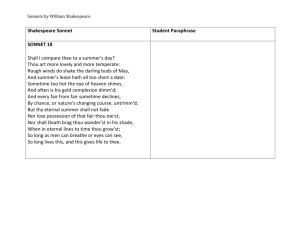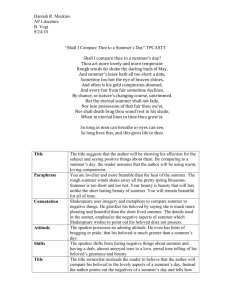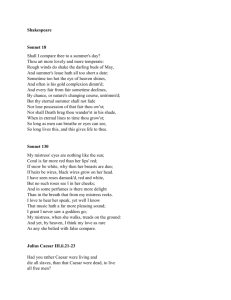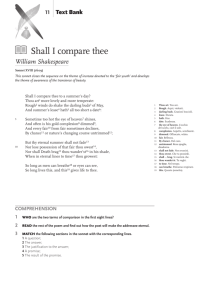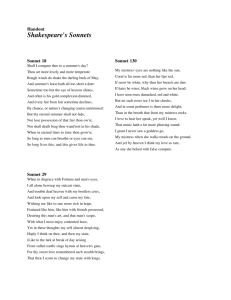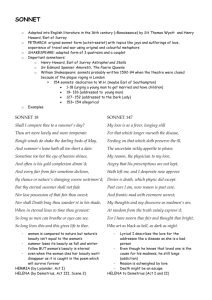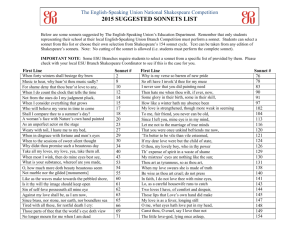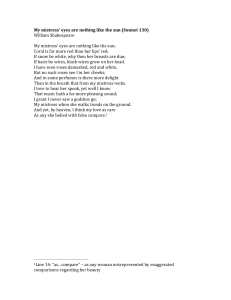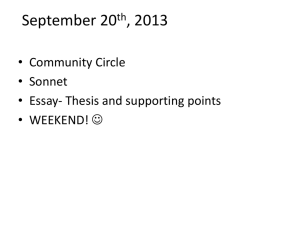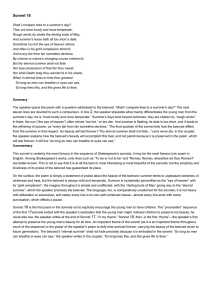Shall I compare thee to a Summer's Day?
advertisement
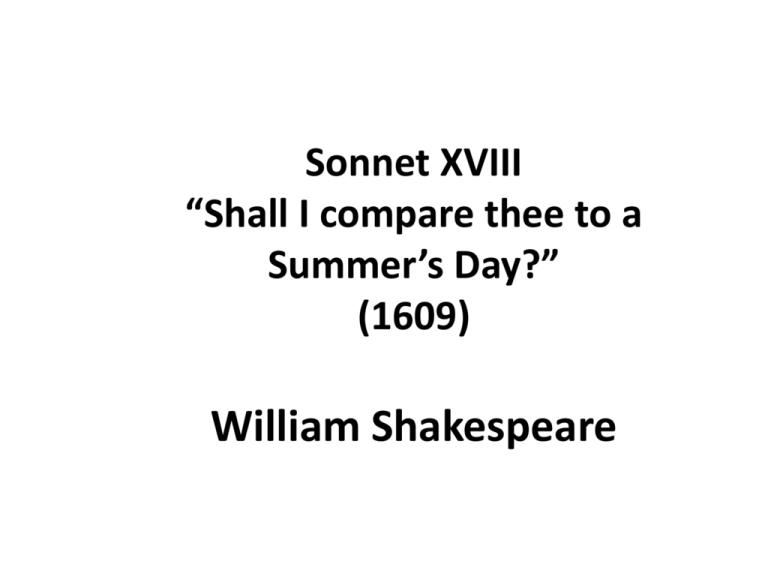
Sonnet XVIII “Shall I compare thee to a Summer’s Day?” (1609) William Shakespeare Shall I Compare Thee to a Summer’s Day? 1.Shall I compare thee to a summer’s day? 2.Thou art more lovely and more temperate. 3.Rough winds do shake the darling buds of May, 4.And summer’s lease hath all too short a date. 5.Sometime too hot the eye of heaven shines, 6.And often is his gold complexion dimmed; 7.And every fair from fair sometime declines, 8.By chance, or nature’s changing course, untrimmed; 9.But thy eternal summer shall not fade, 10.Nor lose possession of that fair thou ow’st, 11.Nor shall death brag thou wand’rest in his shade, 12.When in eternal lines to Time thou grow’st. 13.So long as men can breathe, or eyes can see, S 14.o long lives this, and this gives life to thee. LANGUAGE THROUGH LITERATURE 1. Highlight in the first two quatrains the expressions linked to the idea of Time and its representation. Group them to these headings. parts of the year “summer “(l.1), “May” (l.3); natural elements “Rough winds” (l. 3), “darling buds” (l.3) metaphors “summer’s lease” (l.4), “the eye of heaven” (l.4), “gold complexion” (l. 6). 2. Now highlight in yellow the expressions suggesting the effects of Time. “Do shake” (l.3), “hath all too short a date” (l. 4), “too hot ... shines” (l. 5), “is .... dimmed” (l.6), “decline” (l. 7), “untrimmed” (l. 8). 3. Look at the third quatrain and highlight the expressions suggesting that Time will not affect Shakespeare’s beloved. “shall not fade” (l. 9), “Nor lose possession” (l. 10), “Nor shall Death brag (l.11). 4. 5. Point out all the expressions which give the idea of contrast and explain them. rough winds darling buds; (l.3); too short a date thy eternal summer (ll. 4,9); thou wander’st in his shade in eternal lines (ll. 11,12). Consider these adjectives linked to Time-words: “rough winds”, “gold complexion”. Choose more adjectives among the following. Some of them can be referred to both. fierce – pale – good – dark – balmy – stormy – yellow – fresh – light wild – smooth – healthy – strong – sickly – mild – brown a. What can winds be like? rough, fierce, balmy, stormy, fresh, light, wild, healthy, strong, mild. b. What can complexion be like? gold, pale, good, dark, yellow, fresh, light, smooth, healthy, sickly, brown GUIDED ANALYSIS 1. Read the first two quatrains. a. – b. – c. – d. – What is the beautiful young lover compared to? To a summer day. What images does the poet use to represent summer? Rough winds, the shortness of the season, the excessive heat, the quick decay of nature. Who proves better in comparison: nature or the beloved friend? The beloved friend’s beauty is far better than the beauty of summer because he is not subject to the sudden changes the season undergoes in such a short period of time. What recurring theme does Shakespeare debate in these quatrains? Once again the theme of Shakespeare’s sonnet is tragedy due to the precariousness of things and of nature where everything changes and nothing lasts. 2. 3. Read the third quatrain and the couplet. a. What does the poet predict? ̶ He predicts that the fair youth’s summer will be eternal. b. What will give his beloved friend immortality? – Poetry will give his beloved life after death because he will become the subject of the poet’s poems. Focus on the structure a. Does this sonnet have the usual sonnet structure? Which is it? ─ Yes, it has the structure typical of the Shakespearean sonnet which consists of thre quatrains and a final couplet. b. What is the rhyme scheme? ─ The rhyme scheme is abab cdcd efef gg
